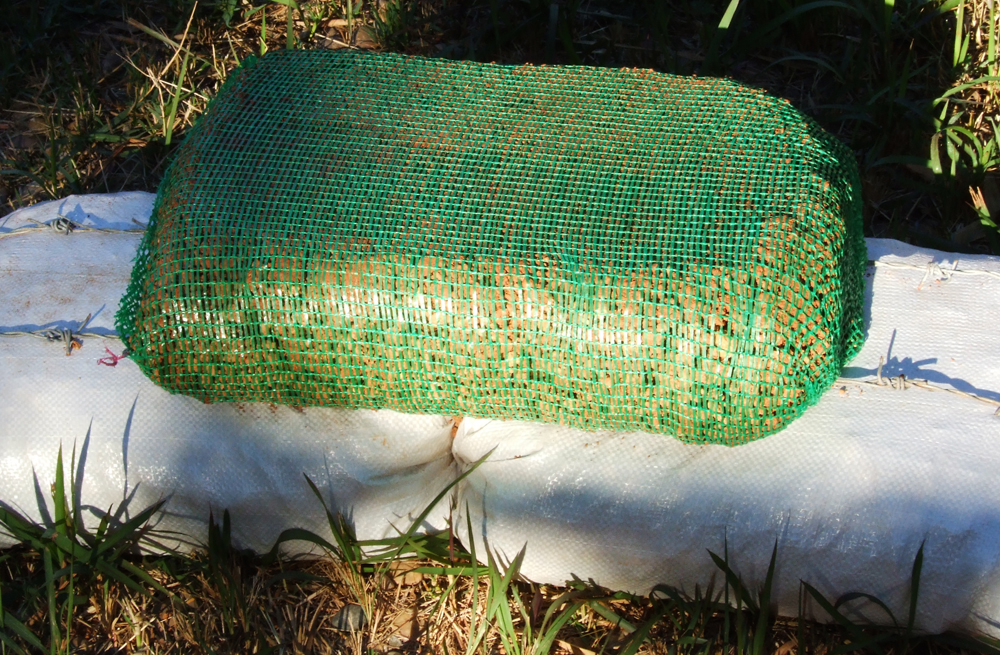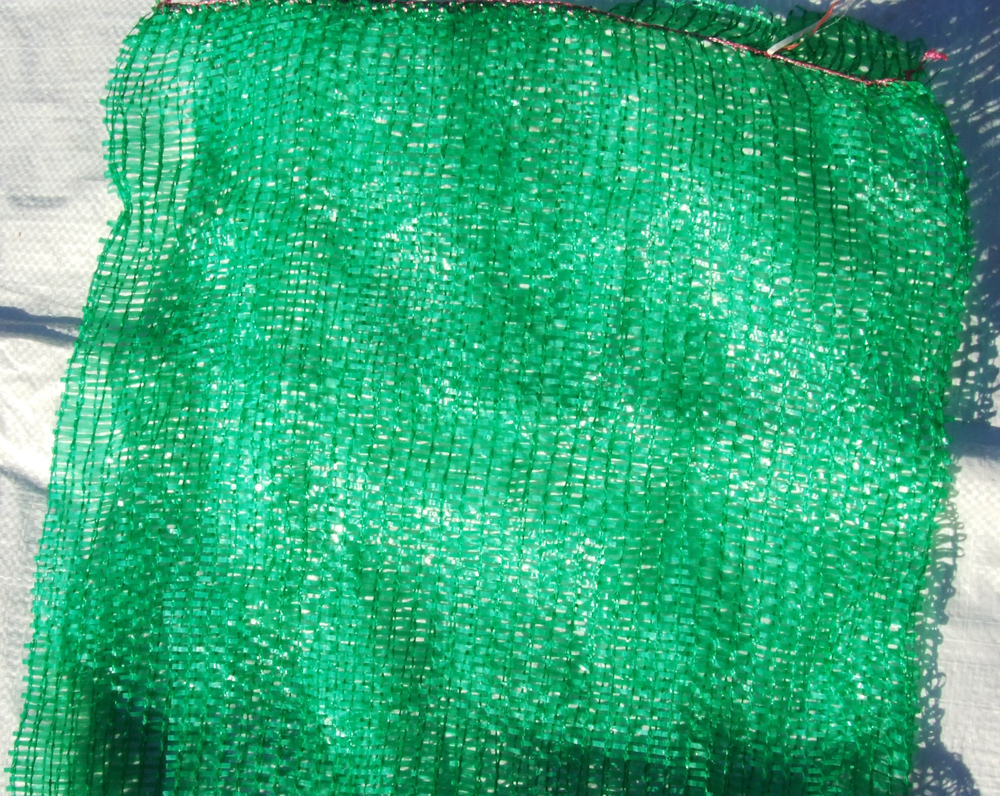

I was able to find some fruit and vegetable bags that seem to match what is being used in Brazil by Fernando Pacheco, the developer of the Hiperadobe earthbag system. What I’ve located is an open weave synthetic fabric, 5 x 10mm weave with 2 x 8mm openings. It has vertical threads and horizontal strips of fabric. They’re called raschel mesh bags or raschel bags in the industry. (Google those terms for lots of photos and details.)
My initial impressions are very favorable: extremely tough, no ‘give’ or stretch when pulled by hand and no sign of tearing during tamping. It has ideal working properties for earthbag walls in virtually every regard. In addition, the material looks almost identical to shade cloth that’s used to shade plants in nurseries and plant stores except it lacks the glossy coating. More testing is needed to determine its ultraviolet (UV) resistance.
Amazingly the 16” x 32” open weave bags expanded slightly to about the same width as standard earthbag walls once filled and tamped: 14-1/2” for open weave in comparison to 15” for poly earthbags. And the openings are just the right size so there’s virtually no spillage with our clay/aggregate road base mix. (The clay clumps the aggregates together like glue.)
So now we have another standard, commercially available product that works perfectly either by itself or in conjunction with poly bags. This to me is a game-changer, folks. Anyone sitting on the sidelines can now use this improved system to reduce costs and labor, and speed construction. I encourage everyone to buy a few bags and test this out. Your results may vary. We’ve already had one report of very weak vegetable bags.
Summary of benefits:
– Final wall thickness nearly identical to poly bags (about ½” narrower)
– Negligible spillage (maybe 1-2 tablespoons of dry crumbs fell through the bag)
– Excellent strength – perfect for earthbag building
– The rough texture creates more friction between courses, thereby eliminating the need for barbed wire on vertical wall designs (non-seismic areas only)
– Improved bonding with barbed wire if it is used (they’re drawn together almost like magnets and are difficult to separate)
– Enhanced bonding with plaster (it’s as if the bags are wrapped in plaster mesh)
– The open weave fabric is made with less material (about half as much), which lowers its environmental impact
– The bags are probably less expensive, because the merchant at the farmer’s market sold me the bags at less cost than poly bags, even though they were in perfect condition. I’ll report on the cost once I find the supplier.
– Much faster drying (noticeable drying in just one hour in the sun)
– More monolithic structure due to direct bonding between courses
– Standard, readily available product that’s sold locally as bags
– No doubt the same size tubes are available (bags are cut from tubes), which would speed wall construction
– Possibly greater UV resistance (yet to be verified)
– Ease of filling and handling: the fabric readily slid onto the end of a bucket chute and bunched up nicely (less stiff than poly bags)
– They handled almost exactly the same as poly earthbags (same skills can be used for both types of bags)
– No protruding corners
Both Kelly Hart and I see this as a major development for earthbag building. The only drawback we can think of is some loose fill material like sand, rice hulls or crusher fines will fall out of the openings.

Am a new enthusiast in hyperadobe construction and was wondering if one could use greenhouse shadwell net instead of raschel bags.
That is an interesting idea; it might work, but you would have to sew up the bags or tubing to do it. You might experiment a bit and see if it seems to work.
“I never thought I would be so excited about new developments in soil filled bags”.
Hahaha!! Me too!! Thanks, Thomas, you’ve described my life!
Acctually, I’m finishing a post graduation on Hyperadobe, lots of new stuff, if you guys should need anything!
Xoxo!
Do you have some new ideas or research to share? You can email to me. My address is at the top of the page under About Us.
How well do you think this would work with crushed cinders/ scoria? Have you found a US source?
It should work fine. We’re currently gathering bags from various suppliers and testing them. A future blog post will report on the best values, and eventually we’ll list the best companies on our Resources page at EarthbagBuilding.com:
http://www.earthbagbuilding.com/resources.htm
Here is the manufacturer in Brazil that has the mesh tube that was specially developed for hyperadobe.
http://www.citropack.com.br/hiperadobe.htm
The only thing is that now they said they will only produce this again if there is a big order….
Thanks, Paula. But it’s okay, there are lots of other suppliers.
Here is an American manufacturer. This product is only 9 1/2 inches wide, but as they make raschel bags, perhaps they can supply wider tubes as well, if they know there is a market for it.
http://www.volmbag.com/ecsnakebag.html
Perhaps the Supplier could be asked to make a run of bags with slightly tighter weave and maybe even denser strands specifically for earthbag building??
Anything is possible, but I’m sure that would raise the cost.
I never thought I would be so excited about new developments in soil filled bags.
Though I would probably still use the poly bags if using rice hulls/volcanic materials for an outer layer of insulation.